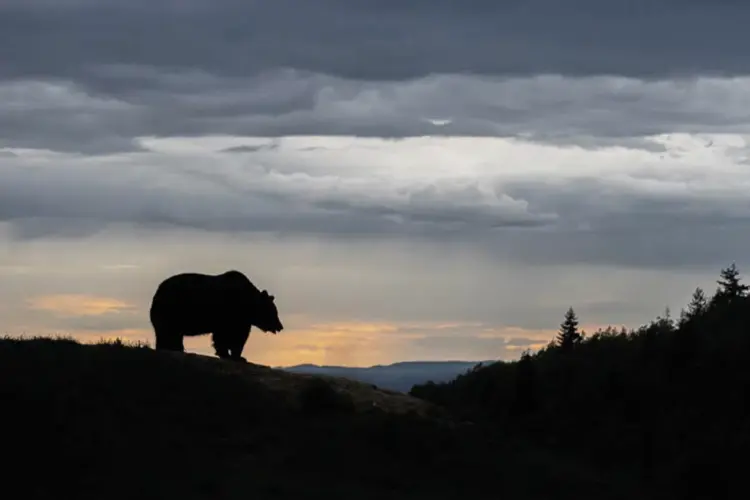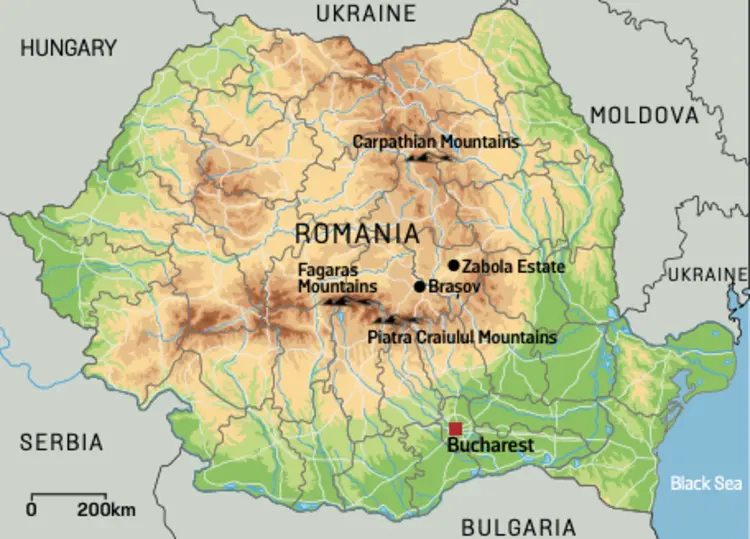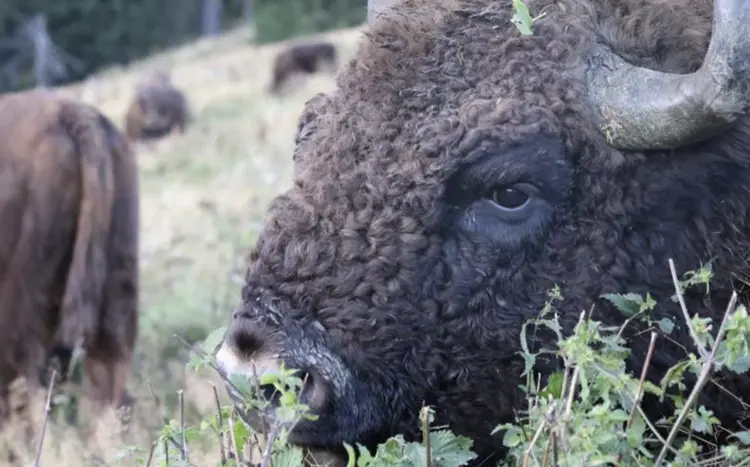
From the quiet woods of Zabola to the high ridges of the Făgăraș Mountains, Bryony Cottam traces Romania’s tangled relationship with the brown bear – part myth, part modern reality
I stood outside my ground-floor room and looked out into the night, listening for the sound of anything. The sky was hidden behind the drooping branches of a large European larch and several Norway spruce trees.
Earlier that day, a black stork had flown out and over the old-growth forest that surrounds the country estate. It was a good spot, I’d been told, for owls, but I was hoping to glimpse another of the forest’s residents. I’d come to Romania to see bears, but the night was quiet and nothing stirred.

We’d driven an hour north from Brașov, a medieval city that sits in the ‘elbow’ of the Carpathians – a sharp right angle where the southern and eastern mountain ranges meet. If we’d followed it, the road would have taken us straight to Oituz Pass, through the mountains and out the other side. Instead, we turned right into a chequerboard landscape of orchards, grazing pastures and fields of maize, wheat and sunflowers. A signpost directed us to ‘Zăbala/Zabola’.
The next morning, I joined the others on the trip for a breakfast of cold smoked ham and cheeses, pork crackling and bread – and a tour of Zabola Estate. Our host, 48-year-old Gregor Roy Chodhury-Mikes, took the lead, four chunky black Labradors in tow.
Zăbala, or Zabola in Hungarian, is a cluster of villages in the southern
end of a Hungarian enclave that spans most of eastern Transylvania, in central Romania. More than a million ethnic Hungarians, Romania’s largest minority, live here, left behind after the Austro- Hungarian Empire collapsed and the Treaty of Trianon redrew the map of Central Europe.
Zabola Estate has been the home of the Mikes – a noble Székely- Hungarian family that has produced influential diplomats, generals and chancellors throughout the history of the old Habsburg Monarchy – since
the 16th century. In the late 19th century, Roy Chodhury-Mikes’s great- grandfather, Count Ármin Mikes, began to modernise the estate, building an adjacent castle – where I’d eaten breakfast that morning – to host guests, and a connecting service tunnel that’s now used to store rows of jars of pickles and jams.

Other buildings that once stored saddles and bridles or water pumps are now guest rooms with stone fireplaces and claw-foot bathtubs. The latest addition is a turquoise spa with floor-to-ceiling windows that look out onto the grounds. It’s all taken a lot of work to restore, admits Roy Chodhury-Mikes. When he took ownership of the estate in the early 2000s, the whole place was in ruins.
On 2 March 1949, the Romanian Communist Party placed all estates over 50 hectares under state control.
That night, families were forcibly evicted. Roy Chodhury-Mikes’s mother, Katalin Mikes, was just three at the time. Spared from the labour camps to which her aunt and great-grandmother were sent, Katalin was placed under forced relocation with another family nearby.
It wasn’t until 1960 that she was able to leave for Austria to join her relatives, where she met her future husband, Shuvendu Basu Roy Chowdhury, whose own family had fled East Bengal during the 1947 partition of India.
After the revolution in 1989, the Romanian government began a huge and chaotic restitution effort. By that time, the state had expropriated nearly all private agricultural land and urban properties, and the resulting legal and bureaucratic battles are ongoing today. Many estates, like Zabola, had been damaged or left to ruin. Others no longer existed at all.
For the Roy Chodhury-Mikes family, the process lasted 15 years. Where the old castle had once sat on 125 square kilometres of land, today the estate comprises just 25 square kilometres.
Aside from the kitchen gardens, where we picked and ate tomatoes off the fragrant vines, there’s no agricultural activity. Instead, the family has made the unusual decision to preserve the forest, which is managed for conservation, and has established a protected corridor across the mountains for wildlife.

Long before the Soviet occupation, before the Habsburg seized Transylvania from the Ottomans, and before the Roman Emperor Trajan conquered the ancient kingdom of Dacia, people and bears coexisted in the land that would become Romania. In Peștera Muierii (the ‘Woman’s Cave’) in the Southern Carpathians, archaeologists found early human remains – some of the oldest in Europe – alongside the fossilised bones of the cave bear, an extinct cousin of the modern brown bear.
The brown bear has long been a national treasure in Romania, revered in the country’s mythology as a totem once believed to ward off evil spirits and bad luck. Villagers in Romania still perform annual bear dances, a pre-Christian tradition.
Even as bear populations dwindled and disappeared across Europe in the 18th and 19th centuries, the Carpathians remained a stronghold. In fact, during the brutal reign of Communist dictator Nicolae Ceaușescu – who banned the hunting of bears for everyone but himself – Romania’s brown bear population burgeoned to around 8,000, a number that far exceeded the landscape’s natural capacity.

The geography of the Carpathian Mountains has been instrumental in shielding Romania’s extensive old- growth forests from logging and human development, which has, in turn, protected its wildlife, including the brown bear. ‘That, and because we were poor,’ Oana Harabagiu, a local guide, later told me. Today, Romania has the largest brown bear population in Europe outside Russia, officially estimated at 6,000 individuals. But something has shifted, and Romania’s relationship with its bears has changed.
A horse-and-cart ride from Zabola Estate, we met Szőke Tibor, a 74-year- old barrel maker – one of a handful of local craftspeople supported by visitors to the estate. His workshop was a jumble of chickens, a small barking dog, wood shavings and barrels of all sizes. We were served glasses of palinka – one brown (plum) and one clear (grape) – a popular Romanian fruit brandy with a high alcohol content. Tibor wasn’t sure how high; we discovered the well-used metal vat it had been made in later.
The bears are no longer afraid of people, Tibor told us. He used to go into the forest behind his workshop to pick mushrooms. He’d never see bears. Now, there are ‘many, many bears’. He doesn’t go into the forest anymore. He’s afraid that if he goes to the village by bike,
the bears will jump out from the maize fields. ‘They need to be shot.’
It’s not certain why there has been an increase in bear attacks in some parts of the Carpathians. Many Romanians believe that a hunting ban imposed in 2016 is to blame.
A study published by Romania’s Forest Research Institute earlier this year, which used genetic analysis to estimate the current bear population, suggests it could actually be almost double the official figure.
What we do know is that some bears have learned that bins and maize fields are an easy source of food, and that expanding human activity is pushing them out of the forests. In the years that followed the country’s land restitution efforts, many newly made owners – long estranged from the land they once worked – sold off their estates to logging companies, a trend that has led to large-scale deforestation in parts of the Carpathians.
We left Zabola Estate with our mountain guide Harabagiu, retraced our steps to Brașov, and headed out into the foothills of the Southern Carpathians.
The Făgăraș Mountains are perhaps the most important wilderness area in the entire Carpathian mountain range. This rugged alpine ridge contains all of Romania’s highest peaks and healthy populations of its largest carnivores – the brown bear, wolf and lynx. The region is the focus of a major conservation project, led by Foundation Conservation Carpathia (FCC), which aims to create Europe’s largest forested national park.

Founded in 2009 by Barbara and Christoph Promberger, two wildlife biologists from Austria and Germany, FCC has invested tens of millions of Euros securing land within the Făgăraș Mountains, replanting trees, and putting a stop to illegal logging – a once pervasive problem driven by a timber mafia, Harabagiu tells me.
The creation of a dedicated hunting association, which acquired the rights for nearly 700 square kilometres of land, immediately ended all hunting activity.
All this work is supported, in part, by ecotourism, including the nearby Comisu Wildlife Hide and Poiana Tămaș Tented Camp. ‘We need to make an economic case for conservation,’ explains Christoph Promberger.
The couple have faced strong, and sometimes strange, opposition, particularly from logging companies.
One local newspaper ran a story claiming the FCC’s forestry school, which runs a junior rangers programme, was brainwashing children. A priest at a nearby church told his congregation that the newly reintroduced beavers would eat their chickens. ‘Some communities claim that “the Germans are stealing our forests!”’ says Harabagiu. ‘They’re the only foundation that’s out buying clear-cut land.

There’s no forest there!’ It’s work, she adds, that the Romanian government should be doing. ‘Even if the national park never happens, there is still so much good that has come out of the project.’

We reached Comisu Wildlife Hide after a spectacular six-hour hike that easily made up for the occasionally gruelling ascent, with carpets of colourful fungi that sprouted from the forest floor and sweeping views of the dark and distant hills.
Periodically, Harabagiu would stop to point out a clump of boar or bear hair stuck to the sap of a spruce tree, the claw and bite marks that a bear had left to mark its territory, or a particularly interesting fungus. There was a lot of prodding at poo, which revealed that our trail had been used – sometimes quite recently – by a fox, pine marten, bison and a lynx.
Our final night, spent in bell tents beneath the jagged limestone ridge of the nearby Piatra Craiului Mountains, was interrupted by the intermittent roar of a rutting red stag and the hoots of a tawny owl. But if any of Romania’s large carnivores had been watching as we’d hauled ourselves uphill, they’d taken care to make sure we wouldn’t know.

Gregor Roy Chodhury-Mikes. Image: Kate Heightmn
We had, however, seen bears on our very first full day in Romania. In the hills above the old Zabola castle, in a hide dug into the soil and with a ground-level view of a clearing and the mountains beyond, we’d held our breath and waited.
Five bears had emerged from the tree cover – one approaching the glass screen of the hide, another silhouetted on the hill against the setting sun. It meant, we all agreed, that we didn’t need to worry for the rest of the week. We’d come to see bears and we’d seen them.

We should all know by now that wildlife watching is unpredictable, and that – in many parts of the world – the urge to tick off a species as ‘seen’ is a driving force behind irresponsible wildlife tourism. Turns out, though, it’s a difficult urge to turn off. Perhaps the best place to start is with a journey where there’s so much else to discover besides. This trip, at least, delivered exactly that.
The European Nature Trust’s Coexistence Adventures offer a seven-day version of this trip at £3,500pp, available in May and September 2026, with more dates coming soon. Zabola Estate and Travel Carpathia offer bookable experiences and stays throughout the year.
Find out more by visiting www.theeuropeannaturetrust.com/travel



